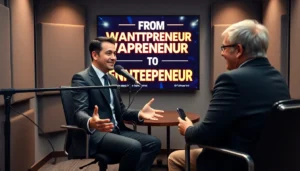Podcasting has taken the world by storm, transforming how people consume content. With millions of shows available, it’s no wonder that aspiring creators are eager to jump into this dynamic medium. Whether they want to share stories, educate listeners, or build a community, the allure of podcasting lies in its accessibility and potential for connection.
Creating a podcast might seem daunting, but it’s easier than ever to get started. With the right tools and a solid plan, anyone can turn their ideas into engaging audio experiences. From concept development to recording and editing, each step plays a crucial role in crafting a successful show. As the popularity of podcasts continues to grow, understanding the ins and outs of podcast creation becomes essential for anyone looking to make their mark in this exciting field.
Table of Contents
ToggleOverview Of Podcast Creation
Podcast creation involves several key stages that contribute to a successful show. These stages include concept development, recording, editing, and publishing.
- Concept Development: Defining the podcast’s niche is crucial for attracting an audience. Creators should consider the target demographic, topics of interest, and the podcast format, such as interviews, storytelling, or discussions.
- Scriptwriting: Preparing scripts enhances clarity and flow. Prioritizing a natural tone and including essential points keeps conversations engaging.
- Recording: Quality equipment is necessary for clear audio. Creators often use microphones, headphones, and audio interfaces. An appropriate recording environment minimizes background noise, improving overall sound quality.
- Editing: Editing software assists in refining audio clips. Editing allows the removal of mistakes, adjusting volume levels, and incorporating sound effects or music, which enriches the listening experience.
- Publishing: Select a reliable podcast hosting platform for distribution. Publishing content consistently, whether weekly or monthly, builds listener loyalty.
- Promotion: Utilizing social media and collaborations can significantly enhance visibility. Creators should engage with listeners and encourage reviews, boosting the podcast’s reach.
Each element of podcast creation plays an integral role in establishing a podcast that resonates with listeners and stands out in a crowded marketplace.
Planning Your Podcast

Planning is crucial for a successful podcast. This stage involves several key steps, including defining the niche and identifying the target audience.
Defining Your Niche
Defining a podcast’s niche establishes a distinct identity. A focused niche helps differentiate the podcast from competitors and attracts a specific audience. Creators should research existing podcasts to identify gaps in content. For example, if a popular category is true crime, sub-niches like unsolved mysteries or forensic science could offer unique angles. Clarity in the niche allows for more targeted content, fostering listener loyalty and engagement.
Target Audience Identification
Identifying the target audience shapes content direction and promotional strategies. Creators must consider demographics like age, gender, and interests when defining the audience. Surveys and social media insights provide valuable data for understanding audience preferences. For instance, a podcast focused on personal finance may target millennials actively seeking financial independence. Tailoring content to meet the needs of the identified audience fosters a stronger connection and improves retention rates.
Equipment And Software Requirements
Selecting the right equipment and software is crucial for successful podcast creation. Quality tools enhance audio clarity and streamline the editing process.
Essential Recording Equipment
- Microphone: A high-quality dynamic or condenser microphone captures clear audio. Popular choices include the Audio-Technica ATR2100x and the Shure SM7B.
- Audio Interface: An audio interface connects the microphone to the computer, converting analog signals to digital. The Focusrite Scarlett 2i2 is a recommended option.
- Headphones: Closed-back headphones, like the Audio-Technica ATH-M50x, help monitor audio without bleed during recording and editing.
- Pop Filter: A pop filter reduces plosive sounds, enhancing audio quality. It’s essential for professional-sounding recordings.
- Boom Arm: A boom arm holds the microphone in place, providing flexibility and reducing handling noise during recording.
- Recording Device: For mobile recording, devices like the Zoom H5 or H6 offer portability with professional sound quality.
Recommended Editing Software
- Audacity: A free, open-source software, Audacity provides essential editing tools. It’s user-friendly and suitable for beginners.
- Adobe Audition: Adobe Audition offers advanced features such as multi-track editing and effects, making it ideal for professional podcasters.
- GarageBand: For Mac users, GarageBand serves as a simple yet powerful tool for recording and editing podcasts.
- Hindenburg Journalist: This software targets spoken-word productions, streamlining the editing process and offering automated leveling for consistent audio.
- Reaper: An affordable, customizable option, Reaper caters to both novice and experienced users, providing a wide range of editing capabilities.
Selecting appropriate equipment and software enhances the overall podcasting experience, ensuring professionalism in audio production.
Recording Your Podcast
Recording a podcast relies heavily on the setup and techniques utilized. These elements directly impact the audio quality and overall listener experience.
Setting Up Your Recording Environment
Choosing the right environment for recording is crucial. A quiet, sound-treated room minimizes external noise and echo.
- Select a Quiet Space: Avoid areas with background noise like traffic or appliances.
- Soundproof the Area: Use rugs, curtains, and foam panels to dampen echoes and reduce sound reflections.
- Control Temperature and Lighting: Ensure a comfortable temperature and adequate lighting to maintain focus and prevent distractions during recording sessions.
- Organize Equipment: Set up recording equipment neatly to avoid tangling cables or accidents during recording.
Best Practices For Recording
Implementing specific best practices during recording enhances audio quality and listener engagement.
- Test Audio Levels: Check microphone levels before recording to ensure a balanced sound without distortion.
- Use a Pop Filter: Install a pop filter to reduce plosive sounds and improve vocal clarity.
- Maintain Consistent Distance from the Microphone: Keep a steady distance—typically 6 to 12 inches—to avoid volume fluctuations.
- Record in Segments: Break down content into segments to make editing easier and allow for retakes if necessary.
- Stay Hydrated: Drink water before recording. A clear voice aids communication and enhances listener enjoyment.
- Monitor Audio While Recording: Listen through headphones during the recording for immediate feedback on audio quality.
By adhering to these guidelines, podcasters can create high-quality audio content that resonates with their audience.
Editing And Producing Your Podcast
Editing and producing a podcast transforms raw audio into polished content that captivates listeners. This stage is essential for ensuring clarity, coherence, and professionalism in the final product.
Editing Techniques
Editing techniques enhance the final audio quality and improve listener engagement. Key methods include:
- Cutting for Clarity: Remove unnecessary pauses, filler words, and irrelevant content to create a smooth, cohesive flow.
- Balancing Audio Levels: Equalize volume levels across different segments to ensure consistent listening experiences. Use normalization techniques to adjust the overall volume.
- Adding Sound Effects and Music: Incorporate music and sound effects to set the tone and mood. Choose royalty-free options or create original compositions to avoid copyright issues.
- Using Multi-Track Editing: Apply multi-track editing when combining various audio clips. This approach allows for precise control over each segment, making it easier to adjust levels and timing.
- Implementing Noise Reduction: Use noise reduction tools to eliminate background sounds, hums, or hisses that distract from the content.
Choosing the right editing software significantly influences the editing process. Programs like Audacity and Adobe Audition offer powerful features for both veterans and beginners.
Creating Engaging Intros And Outros
Engaging intros and outros establish a podcast’s personality and connect with the audience. Effective strategies include:
- Crafting a Hook: Start with a compelling question or statement related to the episode’s topic. This hook captivates listeners’ attention immediately.
- Introducing the Podcast: Clearly state the podcast’s name and purpose within the first few seconds. This helps new listeners understand what to expect.
- Setting the Tone: Use music or voice modulation to establish the tone, whether casual, formal, or entertaining. The tone sets the stage for the entire episode.
- Summarizing Key Points: At the end of the episode, highlight key takeaways to reinforce learnings and encourage reflection among listeners.
- Encouraging Engagement: Use outros to prompt listeners to subscribe, rate, or leave feedback. This engagement fosters a stronger community around the podcast.
Creating high-quality intros and outros enhances the overall listening experience, ensuring the podcast remains memorable and encourages ongoing listener loyalty.
Publishing And Promoting Your Podcast
Publishing and promoting a podcast requires careful consideration of the right hosting and effective marketing strategies. Both elements contribute significantly to the podcast’s reach and listener engagement.
Choosing The Right Hosting Platform
Selecting a reliable hosting platform is crucial for successful podcast distribution. Effective hosting ensures timely uploads, consistent availability, and audience access to episodes. Popular hosting options include:
- Libsyn: Offers extensive analytics, customizable apps, and supports various file formats.
- Podbean: Features user-friendly interfaces and unlimited storage plans, making it suitable for creators of all levels.
- Anchor: Provides free hosting with simple monetization options and easy distribution to major directories.
- Buzzsprout: Presents intuitive tools for uploading, managing, and promoting episodes, along with detailed analytics.
- Transistor: Caters to advanced users with powerful features like multi-user access and private podcasting options.
Each platform varies in pricing structures and storage limits. Creators should evaluate features according to specific needs and long-term goals, ensuring their podcasts remain accessible to target audiences.
Marketing Strategies For Growth
Implementing effective marketing strategies enhances a podcast’s visibility and listener base. Consider these approaches for sustainable growth:
- Social Media Promotion: Use platforms like Facebook, Twitter, and Instagram to share episode teasers, behind-the-scenes content, and listener engagement posts.
- Collaborations: Partner with other podcasters in similar niches for guest appearances, cross-promotions, and joint episodes.
- Email Marketing: Build an email list for newsletters, updates, and exclusive content, keeping listeners informed and engaged.
- Search Engine Optimization (SEO): Optimize show notes, episode titles, and descriptions with relevant keywords to improve discoverability on search engines and podcast directories.
- Listener Engagement: Encourage audience interaction through Q&A sessions, feedback requests, and social media shoutouts, fostering community and loyalty.
By employing a mix of these strategies, podcasters can effectively promote their episodes, increase audience reach, and cultivate a loyal listener base.
Embarking on a podcasting journey offers creators an exciting opportunity to share their voices and connect with audiences. By focusing on essential elements like niche definition and quality production, aspiring podcasters can carve out their unique space in a competitive landscape.
The right tools and thoughtful planning allow for a seamless creation process from concept to promotion. With dedication and the willingness to adapt, anyone can transform their ideas into engaging audio content that resonates with listeners.
As the podcasting landscape continues to evolve, staying informed and embracing new strategies will ensure lasting success and audience growth.


